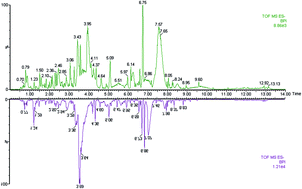High-throughput metabolomics analysis discovers salivary biomarkers for predicting mild cognitive impairment and Alzheimer's disease†
Abstract
Mild cognitive impairment (MCI) confers an increased risk of developing Alzheimer's disease (AD). There is high interest in the discovery of early diagnostic biomarkers that could predict MCI to AD progression, for which saliva metabolomics exhibits a great potential. In this work, the nontargeted metabolomic approach based on fast ultra-high performance liquid chromatography coupled with time-of-flight mass spectrometry (FUPLC-MS) was developed to examine metabolic differences in saliva samples from MCI subjects and age-matched AD subjects; multivariate analyses were used to define the differences between MCI and AD groups; and receiver operating characteristic analysis was used to evaluate the diagnostic power of the candidate biomarkers. Metabolic differences among AD and MCI subjects were identified by principal component analysis. Of note, ten metabolites in the saliva of AD subjects were significantly different from MCI subjects. According to the predictive model, five metabolites were selected as the candidate biomarkers for predicting conversion of MCI to AD. The major contributors were cytidine (P = 0.0003) and sphinganine-1-phosphate (P = 0.0009). The results demonstrated that saliva metabolite profiling may contribute to making early diagnosis and understanding the pathogenic mechanism of AD and MCI.

- This article is part of the themed collection: Towards understanding and treating Alzheimer’s disease

 Please wait while we load your content...
Please wait while we load your content...